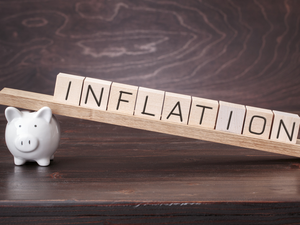 Getty Images
Getty ImagesFall in overall savings rate is cause for concern

WHY DO SAVINGS MATTER?
- Consumption and investment are major components of national income.
- Savings generate funds for investment and support national income.
- Savings are contributed by households, private corporate, and public sector.
- With government expenditure needs exceeding the revenues, the savings were negative. Government dissaving has averaged 2.1% of GDP in the past 10 years.
- Households contribute to most of the gross savings, contributing over 65% in 2021-22.
Higher inflation dragged financial savings in 2022-23

PENT-UP DEMAND DURING COVID DEPLETED SAVINGS
- In the past 10 years, financial savings, as percentage of GDP, have averaged 7.7%. The impact of the pandemic was visible in 2020-21 when savings jumped to 11.5% of GDP. Lockdowns led to reduced spending and higher savings. Job uncertainty also supported the increase in savings. 2021-22 saw pent-up demand, and consumption during the year was funded using excess savings of previous year.
Consumer inflation cooled after RBI stepped in, but it remains high

WHAT HAPPENED IN 2022-23?
- Net financial savings of households plunged to a multi-decade low of 5.2% of GDP in 2022-23, according to the RBI.
- Compared to 2021-22, the net financial savings of households fell over 18.8% y-o-y.
- After Covid-19, the surge in demand, coupled with limited supply, led to a global increase in inflation rate.
- The surge in commodity and energy prices amid the Russia-Ukraine war and dislocation of global supply chains also led to the increase in inflation rate.
- India CPI-Combined averaged* 6.7% in 2022-23 compared to the 10-year average* of 5.4%.
- Higher inflation and loss of purchasing power negatively impacted household savings.
Change in household assets and liabilities (y-o-y %) in 2022-23

HOUSEHOLD ASSETS AND LIABILITIES
- Among assets, bank deposits witnessed a healthy growth in 2022-23 supported by an increase in deposit rates.
- While life insurance, PF and pension funds, and mutual funds saw an increase in household investments, small savings schemes and cash or currency holdings saw a decline.
- Surprisingly, investment in direct equities declined by over 52% after growing by 26% y-o-y in 2021-22.
- In liabilities, loans from the banking sector grew despite multiple repo rate hikes by the RBI.
- The proportion of nonmortgage loans in household liabilities is rising*, indicating increasing reliance on loans to fund consumption expenditure.
How the household liabilities surged

WHY IS IT CAUSE FOR CONCERN?
- Decline in savings will create challenges for the government to finance its fiscal deficit.
- Household liabilities have risen significantly in 2022-23 compared to assets on a y-o-y basis.
- Real income of households (net of inflation) has decelerated in the past four years.*
- Household debt as percentage of GDP rose to 37.6% in 2022-23 compared to 36.9 in 2021-22.
- Falling income levels and rising borrowings affects households' loan repayment ability and increase lenders' default risk.
- Lower household savings will keep interest rates elevated. Higher interest rates negatively impact corporate investments.
Households major contributors to domestic savings

HOW DO HOUSEHOLDS SAVE?
- There are two components of household savings: financial and physical.
- Financial savings (or net financial savings) is the difference between financial assets and liabilities.
- Financial assets include bank deposits and investments in financial institutions, life insurance, PF, equity, mutual funds and small savings schemes.
- Financial liabilities include loans from banks and NBFCs.
- Physical savings include investments in land, buildings and gold.
Share of physical savings rose

LOW RATES DURING COVID LED TO SHIFT
- Recent RBI savings data captures only financial, not physical, savings.
- While financial savings have declined, experts believe savings in physical assets have gone up.
- Share of physical assets is expected to reach 70% level* in 2022-23 from 61% in 2021-22.
- Low interest rates in Covid led to a shift from financial to physical assets.
- Revival in real estate sector and increased property prices also contributed to the shift*. (*SBI Research.)
- Physical savings are not available to the corporate sector for investment and, therefore, not productive.
- SBI Research estimates that the total household savings for 2022-23 will surpass 2021-22 levels despite the decline in financial savings, and will outstrip the rise in household debt.
- Systematix report says that the overall gross savings for households in 2022-23 are estimated to have contracted by 4.6% y-o-y.
- Motilal Oswal report raised concerns about sustainability of economic growth. A further fall in financial savings looks difficult, which could mean weak consumption growth or a decline in household investments in 2023-24.

Read More News on
(Your legal guide on estate planning, inheritance, will and more.)
Download The Economic Times News App to get Daily Market Updates & Live Business News.






 Get Unlimited Access to The Economic Times
Get Unlimited Access to The Economic Times

